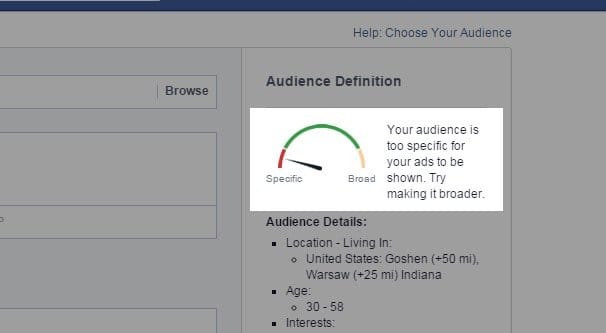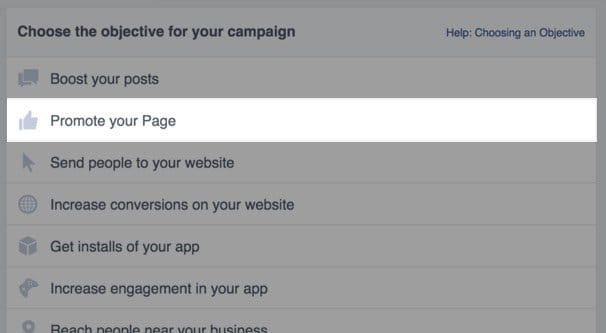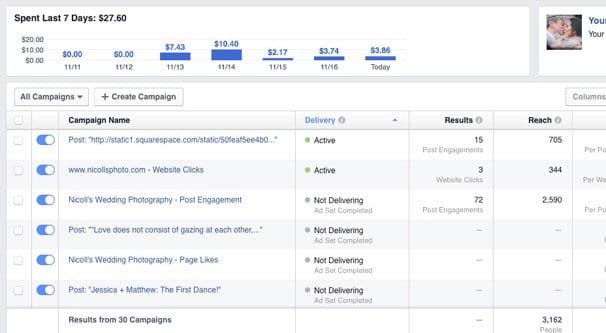 Written by ContentPowered.com
Written by ContentPowered.com
As we’ve discussed time and again, Facebook ads are a complex system that requires quite a bit of knowledge, monitoring, and testing to use effectively. Massive blogs have been dedicated to helping you learn, huge tools have been designed for all sorts of budgets to help you manage them, and thousands of companies have been formed to take the work out of your hands for a simple fee.
With any system of sufficient complexity, you will have a broad array of users. Some will be incalculably successful, seemingly living a charmed life, and will become flagship pioneers and influencers. Many will be moderately successful and will have nothing noteworthy to say about it, either positive or negative. Some will fail, but will take the advice of the great sage chumbawamba; they take their lumps and get back up, learn from their mistakes, and move on.
Some few fail and, rather than recognize that they have done something wrong, take to the streets to decry Facebook ads – or any other system – as a whole. “It’s a scam!” they shout, to mostly disinterested ears. They were unable to get the results they wanted, but they did everything perfectly, so the fault must lie with the site itself. However, in all likelyhood, they did nothing correctly.
I assume that most of the people reading this blog fall in the middle of the bell curve; somewhat successful or relatively new to the system, so they can use all the help they can get. One issue that often comes up with readers like you is knowing how to tell whether or not your ads are working as intended, or if they’re underperforming and you’re wasting money.
If you’re not practiced at reading your analytics, or if you simply don’t know what to look for, here are some warning signs.
You Aren’t Spending Money
This first one isn’t a huge issue in terms of budgetary disaster, but it does herald something wrong with your ads in a way that prevents them from being successful. Essentially, you set up all of your ads, your budget, and everything, and you set them to run. You come back later and notice a problem; you don’t seem to have been charged at all. You check and sure enough, your budget has barely been scratched. You might have spend 30 cents a day when your budget allowed for $5 per day, for example.
Corresponding with this lack of expenditure is a lack of visitors. If you’re not paying for ads, you’re not getting traffic, regardless of other factors. You have no delivery, even though you have the money for it. This indicates that you’re wasting time with incorrectly created ads, though at least you aren’t getting an unpleasant financial surprised.
So what could lead to a lack of delivery and corresponding lack of cost? There are three primary reasons.
The first reason is too low of a daily budget cap. If you’ve set up a target audience that Facebook estimates will cost, say, 80 cents per click, and you set your daily budget at $1 per day, you’d think you’d get one click per day. However, other factors, like having too much text in your ads or having a low quality score, will increase costs. Now you’re looking at $1.10 per click, out of your $1 per day limit, resulting in 0 clicks. The worst part is that this can change from day to day, so some days will get you traffic and others won’t. This exact scenario is pretty unlikely, but it can happen with small campaigns and strange budget limitations, so be careful.
The second reason is too narrow of a target audience. Facebook does a pretty good job of showing you an estimate of how wide your audience is going to be when you plug in your targeting factors. Each successive factor tends to narrow your audience, since you’re looking at the conjunction of everyone who shares each trait, not anyone who has at least one. It’s the intersection of a Venn diagram.
If you add on too many targeting factors, your audience will get too small. Now, “too small” might be relative; it could still contain tens of thousands of people. The problem is, in all of the billion people on Facebook, only a fraction of them are reliably online. Your 10,000 potential users might only include 100 people who log on every day, or even every week. Some of them might be fake accounts who never see your ads anyway. You just end up waiting for the right people to show up to see your ads, and even then they might not browse in the right way to actually be exposed. Then you have the trouble of conversion rates even further lowering how effective the ads may be.
The third reason is having your ads paused or cancelled almost immediately upon starting them. This generally happens when an ad somehow slips through the ad quality scans and is approved, but is actually violating some rule or is insulting to the viewer and is immediately reported as spam. You might get a few views – or a few hundred views – before the ad is processed again and paused until you fix it.
You Aren’t Gaining Followers
Now let’s move on to reasons why you might be wasting money, rather than just time. In these cases, you tend to be spending money but not getting your ad objective. Different ad objectives have different issues, so we’ll take them one at a time.
The generally most common new ad objective for a Facebook advertiser is to get more Facebook followers. It’s the easiest to implement, easiest to track, and generally easiest to run as a novice advertiser. It’s also easy to run for a while and look and wonder why you don’t have as many followers as you thought you should.
Sure, any time you run ads you’re going to gain followers, almost regardless of what the ad objective is. There are some people out there to compulsively follow every page they come across. Other people are part of click farms and will like every page they see to mask their paid liked.
If you’re running ads and paying for them, but you’re not gaining followers, it means you’re using an exposure based model for ads. It might be one that’s just aimed at getting views, or it might be one that looks to get app installs or video views or something else that doesn’t fit with your real intended objective.
There are all sorts of issues that can lead to ads being clicked but not getting followers. The most common in general is a poor brand page. When a user clicks the ad they’re taken to your brand page, where they can see things like your reviews, your posts, and your profile. If your profile is incomplete or looks like something the user doesn’t care about, they aren’t going to like it. If it looks inactive, like if your most recent three posts were posted in 2016, 2015, and 2014, they aren’t going to follow. After all, there’s nothing of value there for them.
Your New Followers are Clearly Bots
Bots are a plague on Facebook and all of the other social networks, though they’re less of an issue with Facebook ads than they are when buying from third parties or on Twitter. Facebook has reasonably decent filtering going on, and bots on Facebook don’t necessarily find you through your ads. However, you might discover that the majority of the new followers you’re getting from your ads are suspiciously bot-like in nature, when you investigate further.
If this is the case, it’s obviously bad for you, because bots are terrible for engagement and conversions. Look at a sample of them and try to figure out what qualities they share that may have put them in your target audience, and try to exclude a common quality. If successful, you’ll be able to filter out that segment of bot traffic from your ads and save some money.
Your New Followers are Outside Demographics
Much more common an issue than bot traffic is traffic that is simply outside of your ideal demographics. These users are real people, but they’re also going to cause issues because they will either not engage or won’t be able to read your posts in their native language. Even if they can read them, they’re unlikely to click through to your site and buy your product, making them much less valuable as followers. They’re just fluff, essentially.
The most common form of out-of-demographic follower is someone from one of the clickfarm countries. India, the Philippines, Bangladesh, Indonesia, Pakistan, and a whole range of other countries are stereotypically bad for most businesses. However, other audiences, even American audiences, can still be regarded as outside your demographics, if your brand has distinct demographic niches. For example, if you sell feminine hygiene products, getting a bunch of men following your page is unlikely to be beneficial.
The driving motivation that ends up with these sorts of ineffective audiences is a desire for cheaper costs, ironically enough. You might be getting ultra-cheap clicks, even penny clicks, which are difficult to achieve. However, the audience you’re paying for ends up being virtually useless to you. Your individual expenses per click are minimal, but taken as a whole, the entire purchase is useless. You’re wasting money even if you’re gaining followers, because those followers are duds. They don’t do anything for you.
Your Posts Aren’t Gaining Engagement
This one stems from a different ad objective, though it can strike in two ways. The first is through the ad itself. If you’re running ads with the ad objective of “earn more engagement on this post,” you obviously want more engagement on the post. If you’re not getting it, your ad has issues.
What kind of issues? It could be almost anything. The budget issues would prevent the post from being seen, but you would recognize it by not actually paying. Targeting the wrong audience would mean the post is only shown to people who don’t really care and won’t interact with it. You also have the possible issue of the post itself simply not being compelling, which means you have to spend more to get any engagement at all.
This is one of the most complex issues to fix, simply because there’s no one size fits all solution. You need to play with the ads, with different audiences, different budgets, and different posts, to try to see what works.
The other way the lack of engagement can rear its head is on issues with the audience you attracted with ads that are meant to grow your page. When you get people to like your page you’re doing so with the expectation that they become followers who interact with your posts. Most won’t, of course – reach is something like 6% on average and engagement rates are a small percentage of that – but you still want to maintain at least that minimum level of engagement. If your audience grows but your engagement stays the same, it’s an indication that either your content is getting worse or that you’re attracting poor users to be part of your audience.
Your Apps Aren’t Earning Installs
Ads that are aimed at getting app installs fall victim to the same sorts of issues, but it’s a lot easier to see whether or not they work. People aren’t going to use bots to install apps since it’s a much more complex setup for much less profit on their part. Maybe if you’re buying specific app install actions from a third party, but that’s beyond the scope of this post.
All in all, how can you know if you’re wasting money? Just look at what you’re trying to get from your ads, and compare it with what you should be getting on average. Don’t necessarily trust Facebook’s estimates, but do some research. What are the average rates of conversion for your industry? It shouldn’t be difficult to find.




